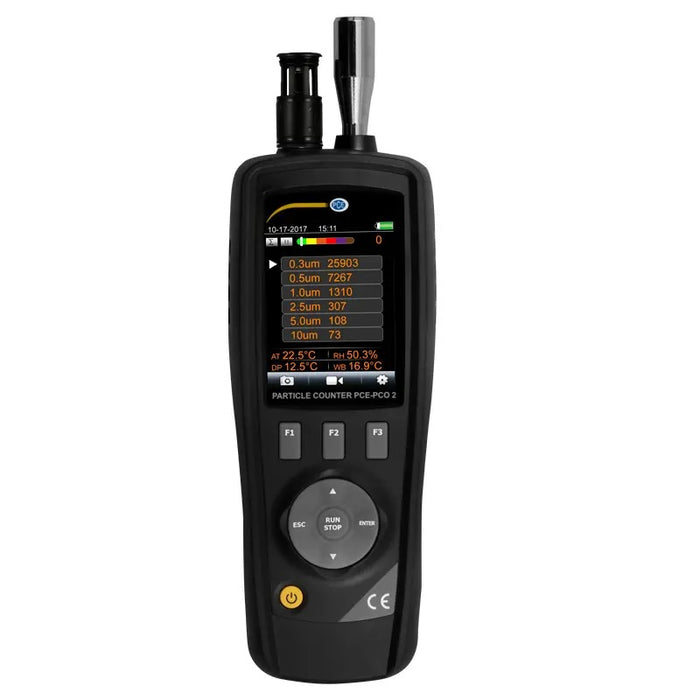

On orders above CAD 99
On orders above CAD 99

This is a portable handheld particle counter used to monitor particulate matter (PM) concentrations in the air. Designed to aid in indoor air quality (IAQ) assessments, this particle counter also measures formaldehyde air temperature, dew point, and relative humidity. The particle counter is ideal for monitoring clean rooms, exposure to exhaust, smoke, and other harmful air pollutants, and levels of airborne combustible dust such as agricultural dust, carbonaceous dust, chemical dust, metal dust, plastic dust, and wood dust. A variety of materials are explosive in dust form. Some examples include food (e.g., candy, sugar, spice, starch, flour, and feed), grain, tobacco, plastics, wood, paper, pulp, rubber, pesticides, pharmaceuticals, dyes, coal, and metals (e.g., aluminum, chromium, iron, magnesium, and zinc). These materials are used in agriculture, chemical manufacturing, pharmaceutical production, furniture, textiles, fossil fuel power generation, recycling operations, metal working and processing (including additive manufacturing and 3D printing), and many other industries and processes.
In addition to being a combustion hazard, certain kinds of dust can be a health hazard. Exposure (such as skin contact, eye contact, and inhalation) can be linked to sneezing, a stuffy or runny nose, itchy or red eyes, headaches, fatigue, fever, cough, shortness of breath, dermatitis, asthma, bronchitis, pneumonia (e.g., Legionnaires’ disease and hypersensitivity pneumonitis) and cancer. When inhaled, PM 2.5 and PM 10 particles can settle deep into the lungs and result in damaging health effects. Since the PCE-PCO 2 particle counter monitors PM 2.5 and PM 10 particles, the device has many practical health and safety applications. Heating, ventilation, and air conditioning (HVAC) technicians use PM 2.5 and PM 10 particle counters for HVAC system performance and filtration audits. In addition, industrial hygienists and workplace safety professionals rely on PM 2.5 and PM 10 particle counters when evaluating occupational health and safety risks related to hazardous and combustible dust.
● Captures 6 particle sizes
● Measures air temperature, dew point, and relative humidity
● 2.8" TFT full-color LCD screen
● Built-in camera for image and video recording
● Cumulative, differential, and concentration particle counting modes
● Stores up to 5,000 data sets in memory
● Power-saving automatic shutdown feature
● PM channels: PM 2.5, PM 10, including mass concentration mode (µg/m³)
● Free software download on PCE Software web page
● 1 x PCE-PCO 2 Particle Counter
● 1 x Zero Filter
● 1 x Rechargeable Battery
● 1 x International Charger
● 1 x USB Cable
● 1 x User Manual
● 1 x CD-ROM (Software)
● 1 x Mini Tripod
● 1 x Hard Case
This is a portable handheld particle counter used to monitor particulate matter (PM) concentrations in the air. Designed to aid in indoor air quality (IAQ) assessments, this particle counter also measures formaldehyde air temperature, dew point, and relative humidity. The particle counter is ideal for monitoring clean rooms, exposure to exhaust, smoke, and other harmful air pollutants, and levels of airborne combustible dust such as agricultural dust, carbonaceous dust, chemical dust, metal dust, plastic dust, and wood dust. A variety of materials are explosive in dust form. Some examples include food (e.g., candy, sugar, spice, starch, flour, and feed), grain, tobacco, plastics, wood, paper, pulp, rubber, pesticides, pharmaceuticals, dyes, coal, and metals (e.g., aluminum, chromium, iron, magnesium, and zinc). These materials are used in agriculture, chemical manufacturing, pharmaceutical production, furniture, textiles, fossil fuel power generation, recycling operations, metal working and processing (including additive manufacturing and 3D printing), and many other industries and processes.
In addition to being a combustion hazard, certain kinds of dust can be a health hazard. Exposure (such as skin contact, eye contact, and inhalation) can be linked to sneezing, a stuffy or runny nose, itchy or red eyes, headaches, fatigue, fever, cough, shortness of breath, dermatitis, asthma, bronchitis, pneumonia (e.g., Legionnaires’ disease and hypersensitivity pneumonitis) and cancer. When inhaled, PM 2.5 and PM 10 particles can settle deep into the lungs and result in damaging health effects. Since the PCE-PCO 2 particle counter monitors PM 2.5 and PM 10 particles, the device has many practical health and safety applications. Heating, ventilation, and air conditioning (HVAC) technicians use PM 2.5 and PM 10 particle counters for HVAC system performance and filtration audits. In addition, industrial hygienists and workplace safety professionals rely on PM 2.5 and PM 10 particle counters when evaluating occupational health and safety risks related to hazardous and combustible dust.
● Captures 6 particle sizes
● Measures air temperature, dew point, and relative humidity
● 2.8" TFT full-color LCD screen
● Built-in camera for image and video recording
● Cumulative, differential, and concentration particle counting modes
● Stores up to 5,000 data sets in memory
● Power-saving automatic shutdown feature
● PM channels: PM 2.5, PM 10, including mass concentration mode (µg/m³)
● Free software download on PCE Software web page
● 1 x PCE-PCO 2 Particle Counter
● 1 x Zero Filter
● 1 x Rechargeable Battery
● 1 x International Charger
● 1 x USB Cable
● 1 x User Manual
● 1 x CD-ROM (Software)
● 1 x Mini Tripod
● 1 x Hard Case